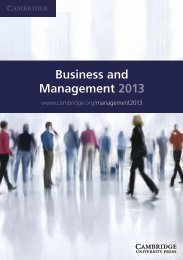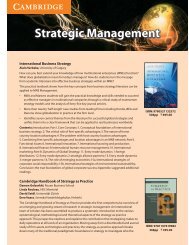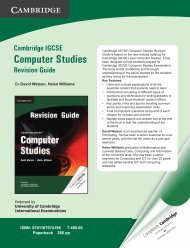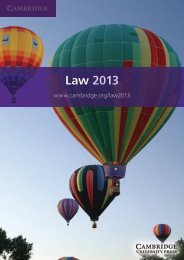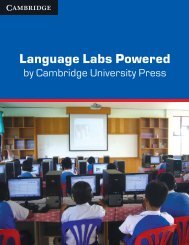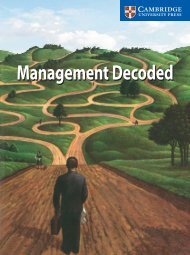ENGINEERING - Cambridge University Press India
ENGINEERING - Cambridge University Press India
ENGINEERING - Cambridge University Press India
Create successful ePaper yourself
Turn your PDF publications into a flip-book with our unique Google optimized e-Paper software.
Foundations of<br />
Cryptography<br />
Vol. 1: Basic Tools<br />
Oded Goldreich<br />
Weizmann Institute of<br />
Science, Israel<br />
Foundations of<br />
Cryptography<br />
Vol. 2: Basic<br />
Applications<br />
Oded Goldreich<br />
Weizmann Institute of<br />
Science, Israel<br />
of mobile data; 12. Mobility and location<br />
information; 13. Active transactions; 14. Mobile<br />
security; Part IV. Putting the Project Together:<br />
15. The mobile development process;<br />
16. Architecture, design, and technology selection;<br />
17. Mobile application implementation hurdles;<br />
18. Testing; 19. A case study.<br />
ISBN: 9780521696234 878pp ` 595.00<br />
Cryptography is concerned with the<br />
conceptualization, definition and construction of<br />
computing systems that address security<br />
concerns. The design of cryptographic systems<br />
must be based on firm foundations. This book<br />
presents a rigorous and systematic treatment of<br />
the foundational issues: defining cryptographic<br />
tasks and solving new cryptographic problems<br />
using existing tools. It focuses on the basic<br />
mathematical tools: computational difficulty (oneway<br />
functions), pseudorandomness and zeroknowledge<br />
proofs. The emphasis is on the<br />
clarification of fundamental concepts and on<br />
demonstrating the feasibility of solving<br />
cryptographic problems, rather than on describing<br />
ad-hoc approaches. The author assumes basic<br />
familiarity with the design and analysis of<br />
algorithms; some knowledge of complexity theory<br />
and probability is also useful.<br />
Contents: Preface; 1. Introduction;<br />
2. Computational difficulty; 3. Pseudorandom<br />
generators; 4. Zero-knowledge proof systems.<br />
ISBN: 9780521670524 392pp ` 495.00<br />
The second volume contains a rigorous treatment<br />
of three basic applications: Encryption,<br />
Signatures, and General Cryptographic Protocols.<br />
It builds on the previous volume which provided a<br />
treatment of one-way functions,<br />
pseudorandomness and zero-knowledge proofs. It<br />
is suitable for use in a graduate course on<br />
cryptography and as a reference book for experts.<br />
The author assumes basic familiarity with the<br />
design and analysis of algorithms and knowledge<br />
of complexity theory and probability.<br />
Contents: Volume II: Basic Applications:<br />
5. Encryption schemes; 6. Signatures and<br />
message authentication; 7. General cryptographic<br />
protocols; C. Correction and additions to Volume I.<br />
ISBN: 9780521670418 448pp ` 495.00<br />
Information Theory,<br />
Inference and<br />
Learning<br />
Algorithms<br />
David J.C. Mackay<br />
<strong>University</strong> of <strong>Cambridge</strong><br />
Information theory and inference, taught together<br />
in this exciting textbook, lie at the heart of many<br />
important areas of modern technology -<br />
communication, signal processing, data mining,<br />
machine learning, pattern recognition,<br />
computational neuroscience, bioinformatics and<br />
cryptography. The book introduces theory in<br />
tandem with applications. Uniquely, the book<br />
covers state-of-the art error-correcting codes,<br />
including low-density-parity-check codes, turbo<br />
codes, and digital fountain codes - the twenty-firstcentury<br />
standards for satellite communications,<br />
disk drives, and data broadcast. Richly illustrated,<br />
filled with worked examples and over 400<br />
exercises, some with detailed solutions, the book<br />
is ideal for self-learning, and for undergraduate or<br />
graduate courses. It also provides an unparalleled<br />
entry point for professionals in areas as diverse as<br />
computational biology, financial engineering and<br />
machine learning.<br />
Contents:1. Introduction to information theory;<br />
2. Probability, entropy, and inference; 3. More<br />
about inference; Part I. Data Compression:<br />
4. The source coding theorem; 5. Symbol codes;<br />
6. Stream codes; 7. Codes for integers; Part II.<br />
Noisy-Channel Coding: 8. Correlated random<br />
variables; 9. Communication over a noisy channel;<br />
10. The noisy-channel coding theorem; 11. Errorcorrecting<br />
codes and real channels; Part III.<br />
Further Topics in Information Theory: 12. Hash<br />
codes: codes for efficient information retrieval;<br />
13. Binary codes; 14. Very good linear codes<br />
exist; 15. Further exercises on information theory;<br />
16. Message passing; 17. Communication over<br />
constrained noiseless channels; 18. Crosswords<br />
and codebreaking;19. Why have sex Information<br />
acquisition and evolution; Part IV. Probabilities and<br />
Inference: 20. An example inference task:<br />
clustering; 21. Exact inference by complete<br />
enumeration; 22. Maximum likelihood and<br />
clustering; 23. Useful probability distributions;<br />
24. Exact marginalization; 25. Exact<br />
marginalization in trellises; 26. Exact<br />
marginalization in graphs; 27. Laplace’s method;<br />
28. Model comparison and Occam’s razor,<br />
29. Morris Carlo methods; 30. Efficient Monte<br />
Carlo methods; 31. Ising models; 32. Exact Monte<br />
Carlo sampling; 33. Variational methods;<br />
34. Independent component analysis and latent<br />
variable modelling; 35. Random inference topics;<br />
36. Decision theory; 37. Bayesian inference and<br />
sampling theory; Part V. Neural Networks:<br />
38. Introduction to neural networks; 39. The single<br />
neuron as a classifier; 40. Capacity of a single<br />
neuron; 41. Learning as inference; 42. Hopfield<br />
networks; 43. Boltzmann machines;<br />
44. Supervised learning in multilayer networks;<br />
45. Gaussian processes; 46. Deconvolution; Part<br />
VI. Sparse Graph Codes: 47. Low-density paritycheck<br />
codes; 48. Convolutional codes and turbo<br />
codes; 49. Repeat-accumulate codes; 50. Digital<br />
fountain codes; Part VII. Appendices: A. Notation;<br />
B. Some physics; C. Some mathematics;<br />
Bibliography; Index.<br />
ISBN: 9780521670517 640pp ` 695.00<br />
45





